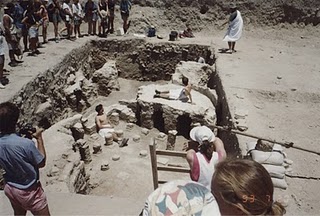"What, where, when?"
First things first, the answer to last month's "What, where, when?" is that the photo shows a Roman period road discovered during the 1992 season. The road and its associated drains were excavated in Grid 2 on the North Tell just outside the ancient city walls. Though exposed the street was never fully excavated and today it is buried under the parking lot just outside the Canaanite Gate
Technology, or How We Get Things Done
The privilege of old age is that I can reminisce with little rhyme or reason about the things that manage to stick out in my memory. So, here are some random thoughts that have managed to linger in the deep recesses of my mind.
Unsurprisingly, over the 20 plus years since I first went to Ashkelon there has been a great deal of change particularly in how we do things. Maybe not going from a horse and carriage to a car level of change but certainly revolutions in both technology and methodology that have changed how we investigate the ancient city. Yep, how we investigate the site and how we stay connected with the wider world as we live in the whirlwind that is an excavation season.
For instance, back in the day technology at Ashkelon meant those ultra thin, light weight air mail letters you could send home. You know the ones you fold and seal shut no envelope needed. That was pretty fancy stuff.
Archaeologically speaking pencil and paper were the recording tools of trade and the only computer on site was a cranky old thing in the dig office that all the supervisors shared along with the team of dig registrars. At the end of the season when square reports were due BEFORE the final dig party that machine saw a great deal of love and attention.
By the early 90s we advanced sufficiently to have access to e-mail. By “access” I mean that the e-mail was sent to the aforementioned cranky old beast in the dig office where it was then downloaded and printed (one screenshot at a time) before being distributed to the designated recipients. And by “we” I mean members of the professional staff. In other words, while a limited few of us had e-mail we had little privacy and certainly few secrets. Did I mention that e-mail came via a 300 baud modem? For those of you not old enough to know what that is, imagine a bunch of hungry alley-cats fighting over food and then toss in a chorus of crying babies. Finally, drop a spoon into the kitchen disposal, listen to all those glorious sounds together and you’re just about there.

Today things are quite a bit different. Pencils and paper are a thing of the past. We actually use laptops in the field to do all our data entry. Anyone with a laptop and I do mean anyone has access to e-mail and the joys of the internet. Need to check the score of the Cubs’s game? You can do that -- just about anywhere you want. Need to update your Facebook page? Doable.
The pervasiveness of computers, both in and out of the field, isn’t the only thing that is different about Ashkelon and the way we do things. In the past few seasons we have started some new projects, one doing ground penetrating radar and another doing core sampling, to help us investigate more areas of the site. These projects use methods that are less invasive than traditional excavation and not only do they help to further our research goals but also they help to shape those goals.
The core sampling project is headed by the team’s geologist Dr. Stephen Moshier who is an Associate Professor of Geology at Wheaton College, Illinois.
Born and raised in upstate New York Dr. Moshier studied geology at Virginia Tech (BS, 1977), SUNY Binghamton (MA, 1980) and Louisiana State University (PhD, 1987). His previous professional experience included working in the petroleum industry and a faculty position at the University of Kentucky. His teaching responsibilities cover areas of general geology, earth history, sedimentary petrology, and geoarchaeology. Prior to 2000, professional interests were focused on ancient limestones and petroleum geology. From 2000 to 2007, Moshier served as team geologist for the Tell el-Borg excavation in the NW Sinai, Egypt and in 2008 he joined the Harvard University-Leon Levy Expedition to Askhelon, Israel.
Dr. Moshier has generously allowed me to reprint some of his blog entries about his work during the 2009 season. The first of two entries will follow after this one.
Now, for the latest “What, where, when?” Any ideas?
One final note, we have a new website for you to check out. The address is digashkelon.com. Visit it to see our flyer about the upcoming season. The site is still under development but check back in the future to see more about Ashkelon and what we do. We also have a new e-mail address, info@digashkelon.com.
Thanks and see you next time!


